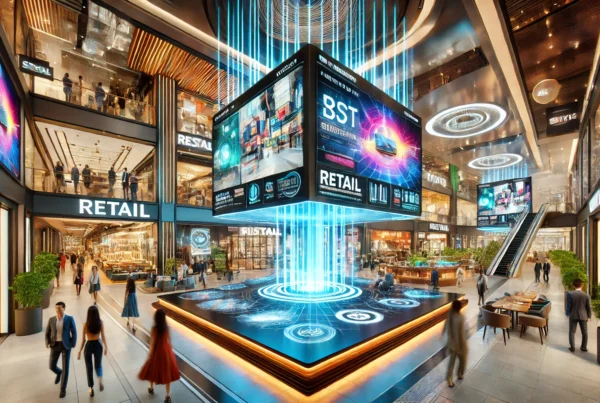Updated: October 31, 2023
Until recently, traditional advertising methods – specifically those in the offline domain – would be continuously outpaced by innovations in digital marketing. However, technological advancements are now expanding the possibilities of offline advertising, equipping businesses with new tools that can significantly boost both efficacy and efficiency.
In particular, the evolution from out-of-home to digital out-of-home (DOOH) advertising marks a major transition in the world of marketing.
What is targeted DOOH Advertising?
Digital out-of-home advertising (also called DOOH advertising, digital signage advertising, and dynamic digital signage) introduces modern technologies such as tracking, geofencing, attribution, personalizing, and measurement to traditional out-of-home (OOH) advertising.
Similar to OOH advertising, DOOH advertising presents branded messaging to consumers in public spaces, including billboards, display systems, and signage. With DOOH advertising, brands and businesses can reap all of the benefits of outdoor/OOH advertising but augmented with AdTech.
The Innovation of DOOH: What it Means
Initially, DOOH technology might seem like something reserved for futuristic sci-fi films: digital billboards that feature dynamic ads personalized to individual viewers, subway displays that change based on the day or the weather, and ads sold in real-time auctions for the ultimate streamlined efficiency. But actually, DOOH advertising is already underway, with new strategies gaining momentum quickly.
Businesses, brands, and marketers should consider how DOOH ad strategies fit into their specific marketing strategies. First and foremost, businesses across all industries will benefit from focusing more on learning what DOOH advertising is, how it works, and what technologies are available. From there, making thoughtful investments in DOOH tools and tactics can be a key step in staying ahead of pivotal trends and competitors.

Like any advertising medium, DOOH does have its challenges. But as a whole, the exciting possibilities of DOOH make it a promising strategy that will likely have a significant impact on OOH marketing. With DOOH advertising, brands can explore new capabilities for:
- Targeting: DOOH ads can be tailored to display when the target audience is more likely to see them, introducing the potential for valuable gains in efficiency and improved media deals. There is even the possibility of leveraging place-based media or weather-based marketing.
- Measurement: Location-based data offers various ways for marketers to measure DOOH ad performance, supporting a better-informed approach to strategy planning, targeting, and execution. For example, mobile data can provide an understanding of the effectiveness of a DOOH campaign, tracking metrics such as purchases, traffic in retail locations, and more.
- Retargeting: Features such as geofencing allow brands to implement retargeting strategies that align with their DOOH campaigns, delivering personalized retargeting messages to consumers that have passed within virtual geographic boundaries surrounding a DOOH ad.
- Increased ad engagement: DOOH creates an environment in which creativity can flourish, enabling brands and marketers to create uniquely engaging campaigns that are unlike the advertising content consumers are used to seeing. As such, there is an opportunity to capture the attention of your target audience in new ways.
Despite the technologically inventive aspects of DOOH advertising, the concept is surprisingly simple. Its foundation is still made up of the media-buying methods already well-known in the advertising industry.
RTB Auctions
Real-time bidding (RTB) is an auction-based bidding system in which various advertisers compete to display their ads to targeted users. With a multitude of inventory options, expansive capabilities, and excellent use of relevant data, RTB is often considered to be the most flexible media-buying model on the market today. Learn more about how CETV Now can Help with RTB Auctions.
Generally, RTB auctions are very minimally used in DOOH advertising.
Programmatic Direct
In a programmatic direct media buying process, they are in a one-on-one relationship that more closely resembles the traditional interactions between advertisers and media salespeople. There are several similarities between the programmatic direct and private marketplace processes, with one important exception. The advertisers and publishers involved in a programmatic direct model have agreed on a specific ad inventory based on a fixed CPM (cost per 1,000 impressions).
Like RTB, the programmatic direct method is fairly limited in DOOH advertising.
Programmatic Guaranteed
Programmatic guaranteed, also called private marketplace or PMP, employs an invite-only approach to the auction process. Selected advertisers have the opportunity to bid for a publisher’s advertising inventory. Major publishers commonly use the programmatic guaranteed method with highly desirable inventory, such as large media sites like Forbes or The New York Times.
DOOH advertising is heavily implemented using a programmatic guaranteed buying method.
Non-Programmatic Guaranteed
Non-programmatic guaranteed requires a significant amount of manual effort from all parties involved. In this manual insertion process, ad inventory is available for purchase at a fixed CPM rate and is reserved (or “guaranteed”) for the client. Advertisers may pay premium prices to secure certain conditions for ad exposure.
This highly versatile method is widely used by advertisers executing DOOH strategies.
Different Components and Types of DOOH Ads
Essentially, anywhere a digital screen can be placed, a DOOH advertisement can be presented. There are currently many DOOH ad types, and we are likely to see even more options become available as marketers push the boundaries of the technology.
DOOH advertisements come in a handful of basic forms, including:
- Large format: From the massive billboards that border a busy highway to digital screens built into city bus shelters, large format DOOH ads are designed to be viewed by street-level traffic and pedestrians. As their name suggests, these types of DOOH advertisements are specifically characterized by their large size.
- Point-of-purchase: Point-of-purchase DOOH ads are based on place-based marketing and are situated in the spaces where a brand’s products are available for purchase. For example, you may see point-of-purchase screens at the checkout counter in a convenience store, pharmacy, or big box retailer, advertising specific products to consumers who are in the process of preparing to make a purchase.
- Place-based: Place-based DOOH advertising is centered around environments that are contextually relevant to the marketing message, including shopping malls, restaurants, gyms, gas stations, office buildings, or university campuses. This ad type is ideal for reaching a specific audience group with highly relevant messaging. For example, a protein shake brand might use place-based DOOH ads to market its products in a local gym.
What is a DOOH System?
A DOOH system is a content management system customized for various campaigns, allowing for the automated creation of “playlists” of DOOH ads. It allows the display network managers to organize a series of ads, so they can be easily played where and when intended.

What is DOOH Display?
A DOOH display is any digital screen equipped with the necessary technology for displaying DOOH ad content. The size, style, and technological features of DOOH displays vary considerably. For example, some DOOH display screens may use touchscreen technology to create an interactive ad experience.
What is DOOH Billboard Technology?
DOOH billboards are precisely what they sound like: billboards that display DOOH advertising. These billboard types are notably more advanced than traditional billboard formats, relying on digital technology rather than large-format printed material.
Get Started on DOOH Ads with CETV Now!
There’s no question that DOOH advertising has quickly become a necessity for brands and businesses that want to maximize the potential to reach targeted audiences with highly engaging messaging – and achieve impressive efficiency in the process. When skillfully executed, DOOH ads can provide outstanding ROI and become a key asset in your overall marketing strategy.
CETV Now! is a leader in DOOH technology and ad insertion, providing our clients with access to a distinct range of benefits. We offer key capabilities such as custom budgeting, global ad placement, and highly tailored campaign parameters so that you can make a smart investment in DOOH marketing.
Learn more about our ad insertion services and contact our team for a free service quote today!
Imaging Credit; Shutterstock users Rawpixel.com / Kicking Studio / Zapp2Photo









